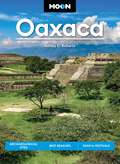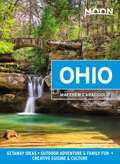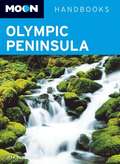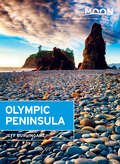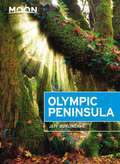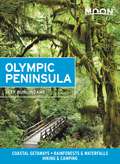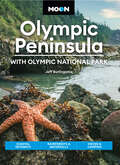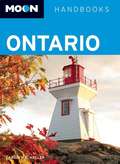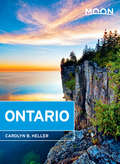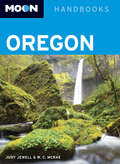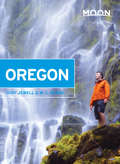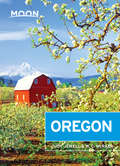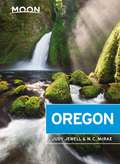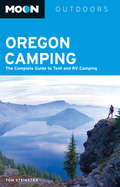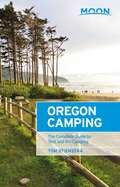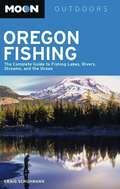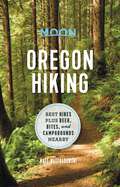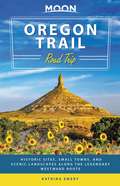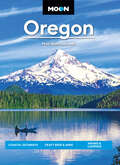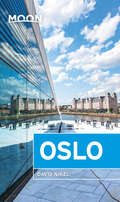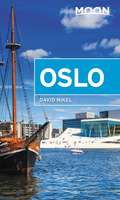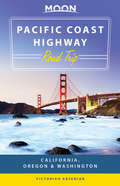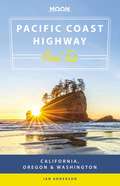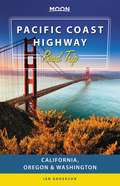- Table View
- List View
Moon Oaxaca: Archaeological Sites, Best Beaches, Food & Festivals (Moon Latin America & Caribbean Travel Guide)
by Moon Travel Guides Ashley C. RobertsWith rugged mountain ranges and stunning Pacific coastline, savory mole and smoky mezcal, Oaxaca is more than just a stop along the way: it&’s an adventure in itself. Stay a while with Moon Oaxaca. Inside you&’ll find:Strategic itineraries, whether you&’re spending ten days or just a weekend in Oaxaca The top activities and unique experiences: Spend a day strolling Oaxaca City&’s cobblestone streets and stopping in trendy cafes, mezcal shops, artisan cooperatives, and art galleries. Tour the Zapotec ruins of Monte Albán, trek the mountain paths of the Sierra Norte, or surf the world-class swells off Oaxaca&’s coast. Revel in the blur of parades, fireworks, and friendly locals inviting you to view their ofrendas (altars) during Oaxaca&’s legendary Day of the Dead celebration The best local flavors: Indulge in steamy pozole from a street stand, try traditional mole, or snack on fried grasshoppers. Visit a mezcal distillery to sample the smoky spirit and explore the fields of spiky agave, or satisfy your sweet tooth with a frothy espuma drink Local insight: Mexico writer and former Oaxaca dweller Ashley Robertson shares why Oaxaca is her favorite state Full-color photos and detailed maps throughoutHelpful background on the landscape, culture, history, and environment, plus tips on health and safety, how to get around, and a handy Spanish phrasebook With Moon&’s practical tips and local insight, you can experience the best of Oaxaca. Looking for más Mexico? Check out Moon San Miguel de Allende or Moon Mexico City.About Moon Travel Guides: Moon was founded in 1973 to empower independent, active, and conscious travel. We prioritize local businesses, outdoor recreation, and traveling strategically and sustainably. Moon Travel Guides are written by local, expert authors with great stories to tell—and they can&’t wait to share their favorite places with you. For more inspiration, follow @moonguides on social media.
Moon Ohio: Getaway Ideas, Outdoor Adventure & Family Fun, Creative Cuisine & Culture (Travel Guide)
by Matthew CaraccioloFrom cities with old-world charm to endless family adventures in the great outdoors, experience the best of the Buckeye State with Moon Ohio. Inside you'll find:Strategic, flexible itineraries for thrill-seekers, outdoor adventurers, families, and more Unique experiences and fun highlights: Wander Columbus&’s trendy neighborhoods on foot or escape to quiet Amish Country. Feel a rush of adrenaline at the famous Cedar Point amusement park, hit the Rock and Roll Hall of Fame, or spend a day at the zoo with the whole family. Kick back at a brewery (or stay at the world&’s first craft beer hotel!) and chow down on authentic German food The best outdoor adventures: Hike to stunning waterfalls in Cuyahoga Valley National Park, explore hidden caves, or head to the Lake Erie Islands for a quintessential summer camping trip Expert advice from Columbus local Matthew Caracciolo on when to go, how to get around, and where to stay Helpful resources on Covid and traveling to Ohio Full-color photos and detailed maps throughoutThorough information on the landscape, climate, wildlife, and history With Moon's local insight and practical tips, you can experience the best of Ohio. Exploring more of the Midwest? Try Moon Michigan or Moon Wisconsin. About Moon Travel Guides: Moon was founded in 1973 to empower independent, active, and conscious travel. We prioritize local businesses, outdoor recreation, and traveling strategically and sustainably. Moon Travel Guides are written by local, expert authors with great stories to tell—and they can't wait to share their favorite places with you. For more inspiration, follow @moonguides on social media.
Moon Olympic Peninsula
by Jeff BurlingameAuthor and Washington native Jeff Burlingame knows the best ways to enjoy the Olympic Peninsula, from strolling through the subalpine meadows and temperate rain forests of Olympic National Park to soaking and swimming at Sol Duc Hot Springs. Burlingame offers unique strategies so travelers can organize their trips around specific time restrictions and interests, such as A Long Weekend, Seven Days of Highlights, and-for Stephenie Meyer fans-Three Days of Twilight. With details on touring small towns, exploring the coast, and getting lost in nature,Moon Olympic Peninsulagives travelers the tools they need to create a more personal and memorable experience.
Moon Olympic Peninsula
by Jeff BurlingameAuthor and Washington native Jeff Burlingame knows the best ways to enjoy the Olympic Peninsula, from strolling through the subalpine meadows and temperate rain forests of Olympic National Park to soaking and swimming at Sol Duc Hot Springs. Burlingame offers unique strategies so travelers can organize their trips around specific time restrictions and interests, such as A Long Weekend, Seven Days of Highlights, and-for Stephenie Meyer fans-Three Days of Twilight. With details on touring small towns, exploring the coast, and getting lost in nature, Moon Olympic Peninsula gives travelers the tools they need to create a more personal and memorable experience.
Moon Olympic Peninsula: Coastal Getaways, Rainforests & Waterfalls, Hiking & Camping (Travel Guide)
by Jeff BurlingameDiscover endlessly explorable terrain, miles of rugged coastline, and a diverse array of rainforests, lakes, waterfalls with Moon Olympic Peninsula. Inside you'll find:Flexible, strategic itineraries from a weekend in Olympic National Park to a week-long adventure on the peninsulaMust-sees and unique experiences: Hike through wild elk habitats, dig for clams in the wet coastal sand, and soak your tired muscles in the remote Olympic Hot Springs. Kayak beneath snow-topped mountain peaks, fish the abundant rivers, and indulge in local delicacies like Dungeness crab. Wander through the intoxicating Hoh Rain Forest, hike the many trails of Olympic National Park, camp beneath starry skies, or relax with a glass of local Washington wineLocal insight from Washington-born journalist Jeff Burlingame on when to go, where to stay, and what to bringPractical advice on how to get around the Olympic Peninsula, plus how to get there from nearby cities like Seattle and TacomaFull-color photos and detailed, easy-to-use maps throughoutThorough information, including background on the landscape, wildlife, climate, and local cultureWith Moon Olympic Peninsula's expert advice and local know-how, you can plan your trip your way.Staying in the great outdoors? Try Moon Pacific Northwest Camping, Moon Oregon Camping, or Moon Washington Camping. Exploring more of the Pacific Northwest? Try Moon Oregon, Moon Washington, or Moon Seattle.
Moon Olympic Peninsula: Coastal Getaways, Rainforests & Waterfalls, Hiking & Camping (Travel Guide)
by Jeff BurlingameCharming small towns, verdant rainforests, rocky coastline, and mountain meadows: experience the surreal beauty and endless adventure of the Pacific Northwest with Moon Olympic Peninsula. Inside you'll find:Flexible itineraries, from a weekend in Olympic National Park to a week-long tour of the peninsula, for outdoors enthusiasts, families with kids, and moreMust-see highlights and unique experiences: Tour the oldest lighthouse on the Puget Sound, explore Kurt Cobain's hometown, or immerse yourself in the region's rich maritime history. Dig for a dinner of fresh razor clams in the wet coastal sand and savor fresh-caught Dungeness crab. Stroll through a fragrant lavender farm, shop for handcrafted goods, or peruse small-town galleries for local art. Sample one-of-a-kind red blends and fruit wines or kick back with a local brew and some jazz musicThe best hikes of the Olympic Peninsula: Find your adventure with hike descriptions, directions, difficulty ratings, and elevation gainsOutdoor adventures: Wander through the ethereal Hoh Rain Forest, marvel at the panoramic views from Hurricane Ridge, or hike through the old-growth forests of Olympic National Park. Take a waterfall-filled backpacking trek through the Sawtooth Mountains, camp on the banks of the Skokomish River, and soak in the restorative waters of the Olympic Hot Springs. Spot hundreds of species of birds in the largest natural sand spit in the world or study starfish and sea stacks on the rugged northern coastLocal insight from Washington-born journalist Jeff Burlingame on when to go, where to stay, and what to bringFull-color photos and detailed maps throughoutHelpful background on the landscape, wildlife, climate, and local culture, plus tips on getting around the peninsulaWith Moon Olympic Peninsula's practical tips and expert advice, you can plan your trip your way. Want more of the great outdoors? Try Moon Pacific Northwest Hiking. Exploring the Pacific Northwest? Try Moon Pacific Northwest Road Trip, Moon Coastal Oregon, or Moon Seattle.
Moon Olympic Peninsula: Coastal Getaways, Rainforests & Waterfalls, Hiking & Camping (Travel Guide)
by Jeff Burlingame Moon Travel GuidesCharming small towns, verdant rainforests, rocky coastline, and mountain meadows: experience the surreal beauty and endless adventure of the Pacific Northwest with Moon Olympic Peninsula. Inside you'll find:Flexible itineraries, from a weekend in Olympic National Park to a weeklong tour of the peninsula Must-see highlights and unique experiences: Tour the oldest lighthouse on the Puget Sound, explore Kurt Cobain's hometown, or immerse yourself in the region's rich maritime history. Dig for a dinner of fresh razor clams and savor fresh-caught Dungeness crab. Stroll through a fragrant lavender farm, shop for unique handcrafted goods, or peruse small-town galleries for local art. Sample one-of-a-kind red blends and fruit wines or kick back with a local brew and some jazz music The best hikes of the Olympic Peninsula: Find your adventure with hike descriptions, directions, difficulty ratings, and elevation gains Outdoor adventures: Wander through the ethereal Hoh Rain Forest, marvel at the panoramic views from Hurricane Ridge, or hike through the old-growth forests of Olympic National Park. Take a waterfall-filled backpacking trek through the Sawtooth Mountains, camp on the banks of the Skokomish River, and soak in the restorative waters of the Olympic Hot Springs. Spot hundreds of species of birds on the largest natural sand spit in the world or study starfish and sea stacks on the rugged northern coast Local insight from Washington-born journalist Jeff Burlingame on when to go, where to stay, and what to bring Full-color photos and detailed maps throughoutHelpful background on the landscape, wildlife, climate, and local culture, plus tips for getting around the peninsula With Moon Olympic Peninsula's practical tips and expert advice, you can plan your trip your way. Want more of the great outdoors? Try Moon Washington Hiking. Exploring the Pacific Northwest? Try Moon Coastal Oregon or Moon Columbia River Gorge & Mount Hood.About Moon Travel Guides: Moon was founded in 1973 to empower independent, active, and conscious travel. We prioritize local businesses, outdoor recreation, and traveling strategically and sustainably. Moon Travel Guides are written by local, expert authors with great stories to tell—and they can't wait to share their favorite places with you. For more inspiration, follow @moonguides on social media.
Moon Ontario
by Carolyn B. HellerProfessional travel writer Carolyn Heller shares the best ways to experience all that Ontario has to offer, from scuba diving shipwrecks in the Great Lakes to dining on contemporary fare at Toronto's hottest restaurants. Heller leads readers to the highlights of this fascinating region with trip ideas such as Food and Wine Touring, Active Adventures, and History and Culture—providing different approaches for different kinds of travelers. Complete with tips on enjoying more than just the falls on the Niagara peninsula, hopping a ferry to Pelee Island for wine-tasting and relaxation, and ice skating on the world's longest skating rink in Ottawa,Moon Ontariogives travelers the tools they need to create a more personal and memorable experience.
Moon Ontario
by Carolyn HellerProfessional travel writer Carolyn B. Heller shares the best ways to experience all that Ontario has to offer, from scuba diving shipwrecks in the Great Lakes to dining on contemporary fare at Toronto's hottest restaurants. Heller leads readers to the highlights of this fascinating region with trip ideas such as Food and Wine Touring, Active Adventures, and History and Culture-providing different approaches for different kinds of travelers. Complete with tips on enjoying more than just the falls on the Niagara peninsula, hopping a ferry to Pelee Island for wine-tasting and relaxation, and ice skating on the world's longest skating rink in Ottawa, Moon Ontario gives travelers the tools they need to create a more personal and memorable experience.
Moon Oregon
by W. C. Mcrae Judy JewellOutdoors enthusiasts and Portland residents Judy Jewell and W. C. McRae cover the very best of the state inMoon Oregon. From the lush Lost Forest to Sparks Lake, Jewell and McRae offer their firsthand experience in unique trip strategies for a variety of travelers. Complete with expert tips on the best parks, bars, museums, and shopping areas,Moon Oregongives travelers the tools they need to create a more personal and memorable experience.
Moon Oregon
by W. C. Mcrae Judy JewellOutdoors enthusiasts and Portland residents Judy Jewell and W. C. McRae offer unique insight into Oregon's many offerings, from its lush forests and deep river canyons to its award-winning wines and friendly cities. Jewell and McRae include unique trip strategies that connect with travelers' specific interests, such Best Bike Rides, The Wine Route, and As Seen in Portlandia. With information on browsing through the Sisters Farmers' Market, attending Ashland's famous Oregon Shakespeare Festival, and kite-boarding near Hood River, Moon Oregon gives travelers the tools they need to create a more personal and memorable experience.
Moon Oregon
by W. C. Mcrae Judy JewellOutdoors enthusiasts and Portland residents Judy Jewell and W. C. McRae offer unique insight into Oregon's many offerings, from its lush forests and deep river canyons to its award-winning wines and friendly cities. Jewell and McRae include unique trip strategies that connect with travelers' specific interests, such Natural History Road Trip, Eastern Oregon Ramble, and The Wine Route-a seven-day tour of the state's numerous wineries. With information on browsing through the Sisters Farmers' Market, attending Ashland's famous Oregon Shakespeare Festival, and kite-boarding near Hood River, Moon Oregon gives travelers the tools they need to create a more personal and memorable experience.
Moon Oregon
by W. C. Mcrae Judy JewellJoin Oregon experts Judy Jewell and W. C. McRae for an unforgettable experience. With their unique perspective and advice you can trust, Moon Oregon has everything you need to know to have a more personal and memorable experience.Moon Oregon shows you what you need to know to plan the perfect trip for you. Whether you are looking to fill your adventure with night skiing, waterfall hikes, and sand-dune treks or experience a local's perspective on Portland's laid-back lifestyle, Moon Oregon has something for everyone. Along with trip ideas like "Day Trips from Portland" and "Touring the Taps", Jewell and McRae share their advice on local craft breweries, eclectic art shows, and the best places to bike, hike, and raft, as well as suggestions for wine-tasting in the beautiful Willamette Valley.With expertly crafted maps and gorgeous photos, this full-color guidebook gives you the tools you need to have an immersive and unique experience.Moon Oregon includes areas such as:PortlandColombia River Gorge and Mount HoodThe Willamette ValleyNorth CoastCentral CoastSouth CoastAshland and Southern OregonBend and Central OregonNortheastern OregonSoutheastern OregonFind the Moon guide that best suits your trip! Staying in the area? Check out Moon Coastal Oregon and Moon Washington.
Moon Oregon (Travel Guide)
by Judy Jewell W. C. McRaeDiscover Oregon with Moon Travel Guides!The jagged coastline, quirky towns, and stunning breadth of nature: Oregon is like a living postcard. Dig into this unique state with Moon Oregon.Strategic itineraries that can adapted for your timeline and budget, whether you're wine tasting for a weekend, spending a few days in Portland, or road tripping the whole state Curated advice for outdoor adventurers, foodies, culture and history buffs, and moreCan't-miss experiences and unique activities: Sample oysters in quaint seaside towns on a coastal road trip, or get to know Portland's renowned craft beer scene. Hike to rushing waterfalls, soak in hidden hot springs, and spot wild mustangs, gray whales, or eagles. Trek to unbeatable views of Crater Lake, the deepest lake in America, cycle the banks of the Willamette River, or ski the fresh powder on Mount Hood. Catch a performance at the Shakespeare Festival in Ashland, shop for organic produce at a local farmers market, or sip your way through Oregon's best wineriesExpert insight from Oregon locals Judy Jewell and Bill McRaeHonest advice on when to go, how to get around, and where to stay, from Full-color photos and detailed maps throughout Focused coverage of Portland, Columbia River Gorge and Mount Hood, the Willamette Valley, the North, Central, and South Coasts, Ashland and Southern Oregon, Bend and Central Oregon, and Northeastern and Southeastern OregonThorough background information on the culture, landscape, climate, and wildlife, plus handy recommendations for international visitors, traveling with kids, LGBTQ+ travelers, and travelers with disabilitiesWith Moon Oregon's practical tips, myriad activities, and local know-how, you can plan your trip your way.Spending more time in the Beaver State? Try Moon Portland or Moon Coastal Oregon. Hitting the road? Try Moon Pacific Northwest Road Trip.
Moon Oregon Camping
by Tom StienstraTop-selling outdoors writer Tom Stienstra covers the adventures of camping in Oregon, including notable campsites along the Oregon Coast, Portland and the Willamette Valley, the Columbia River Gorge and Mount Hood, as well as the Southern Cascades. Stienstra provides easy-to-follow maps with driving directions to each campground, along with camping options from secluded alpine hike-ins to convenient roadside stopovers. Complete with details on what to pack, what to wear, reservations, fees, and the best camping facilities, Moon Oregon Camping gives travelers the tools they need to create a more personal and memorable camping experience.
Moon Oregon Camping: The Complete Guide to Tent and RV Camping (Moon Outdoors)
by Tom StienstraMoon Travel Guides: Your Adventure Starts HereGrab your sleeping bag, pack the car, and discover the best spots to camp in the great outdoors with Moon Oregon Camping. Inside you'll find:A Campsite for Everyone: A variety of campgrounds and RV parks, from family-friendly car camping to secluded hike-ins, including dog-friendly and wheelchair accessible options Ratings and Essentials: All campsites are rated on a scenic scale and marked with amenities like restrooms, trailhead access, picnic areas, laundry, piped water, showers, and playgroundsRecreation Highlights: Discover nearby hiking, swimming, fishing, water-skiing, whitewater rafting, hot springs, and options for winter sportsMaps and Directions: Easy-to-use maps and detailed driving directions for each campgroundTrusted Advice: Expert outdoorsman Tom Stienstra is always on the move, having traveled more than a million miles across Oregon and the West over the past 25 yearsTips and Tools: Essentials like equipment, food and cooking, first aid, and insect protection, as well as background information on the climate, landscape, and history of the campsitesComprehensive Coverage: Moon Oregon Camping covers Portland and the Willamette Valley, the Southern Cascades, the Columbia River Gorge and Mount Hood, Northeastern and Southeastern Oregon, and the Oregon CoastWhether you're a veteran or a first-time camper, Moon's comprehensive coverage and trusted advice will have you gearing up for your next adventure.Sticking to the RV? Try Moon West Coast RV Camping. Can't get enough of the Pacific Northwest? Try Moon Washington Camping or Moon Olympic Peninsula.
Moon Oregon Fishing: The Complete Guide to Fishing Lakes, Rivers, Streams, and the Ocean
by Craig SchuhmannPack up your rod and reel, stock your tackle box, and head out to fish the best lakes, rivers, and saltwater areas in the Beaver State. Whether you're a first-time enthusiast or a seasoned veteran, you'll find the perfect destination with a range of options selected by expert angler Craig Schuhmann. From the waters of the Columbia River Gorge to the lakes of the Cascades, this is your guide to fishing in Oregon.
Moon Oregon Hiking: Best Hikes plus Beer, Bites, and Campgrounds Nearby
by Matt WastradowskiMisty ancient forests, rugged high deserts, and black sand beaches: wherever you turn in Oregon, adventure awaits. Pack a lunch, lace up your boots, and hit the trails with Moon Oregon Hiking. Inside you'll find:Diverse Hiking Options: Whether you plan to take peaceful walks along the coast or challenging treks up Mount Hood, enjoy outdoor getaways ranging from easy day hikes to multi-day backpacking tripsFind Your Hike: Looking for something specific? Choose from strategic lists of the best hikes for wildflowers, waterfalls, or hiking with your dog, plus a breakdown of the best hikes by seasonThe Top Outdoor Experiences: Explore a Mars-like red rock landscape in the Alvord Desert, or marvel at one of the 90 rushing waterfalls in the Colombia River Gorge. Peer into the mouth of a volcano crater, gaze at the Portland skyline from afar, or climb to the top of a picturesque lighthouse. Take a dip in relaxing hot springs, study real wagon ruts on the historic Oregon Trail, and spot puffins, pelicans, and plovers along the coastNearby Fun: Spend a night under the stars at a nearby campground, sip a refreshing local brew after a day of hiking, or enjoy fresh-caught fish at a beachfront restaurant Essential Planning Details: Each hike is described in detail and marked with round-trip distance and hiking time, difficulty, terrain type, elevation gain, and access pointsMaps and Directions: Find easy-to-use maps, driving directions to each trailhead, and details on where to parkExpert Advice: Seasoned hiker Matt Wastradowski offers experienced insights, local secrets, and honest opinions of each trailTips and Tools: Advice on gear, first aid, and camping permits, plus background information on climate, landscape, and wildlifeWhether you're a veteran or a first-time hiker, Moon's comprehensive coverage and local expertise will have you gearing up for your next adventure.Hitting the road? Check out Moon Pacific Northwest Road Trip!
Moon Oregon Trail Road Trip: Historic Sites, Small Towns, and Scenic Landscapes Along the Legendary Westward Route (Travel Guide)
by Moon Travel Guides Katrina EmeryVast rugged prairies, adventurous Wild West towns, and the palpable spirit of the pioneers: Experience legend come to life with Moon Oregon Trail Road Trip. Choose Your Route: Drive the entire 20-day road trip from Independence, Missouri, to Oregon City (at a mild, moderate, or strenuous pace!) or take shorter getaways along sections of the trail in Kansas, Nebraska, Wyoming, and Idaho, including worthwhile detoursDrive Through History: See the Guernsey Ruts left from wagons almost 200 years ago, read pioneer names carved into Register Rock, and learn about 10,000 years of oral Umatilla history. Practice loading a real wagon, down a mug of sarsaparilla in a recreated Old West town, and take a relaxing soak in the same hot springs as the pioneers Discover Diverse Historic Perspectives: Delve into the rich cultures and histories of the Native American tribes who have called these lands home for over 10,000 years. Venture through an underground city created and inhabited by Chinese pioneers. Learn the stories, struggles, and triumphs of free and enslaved black emigrants on the trail. Discover what life was really like for women making the journey westAdventure Along the Trail: Tube through the whitewater of Platte River, explore limestone caves, and kayak across clear blue lakesMaps and Driving Tools: Easy-to-use maps and full-color photos throughout keep you oriented on and off the highway as you follow the approximate route of the original Oregon Trail, along with site-to-site mileage, driving times, and detailed directionsExpert Insight: Oregon local and history buff Katrina Emery shares thorough background on the realities of the trail and recommendations for seniors, families with kids, and moreWith Moon Oregon Trail Road Trip's flexible itineraries and practical tips, you're ready to take an adventure through history. Looking to explore more of American history? Try Moon Route 66 Road Trip.
Moon Oregon: Coastal Getaways, Craft Beer & Wine, Hiking & Camping (Travel Guide)
by Matt WastradowskiStunning coastline, quirky towns, and a breathtaking array of natural wonders: Experience the best of the Beaver State with Moon Oregon. Inside you'll find:Flexible itineraries, whether you're visiting the Oregon Coast, checking out the Columbia River Gorge and Mount Hood, or road-tripping the whole state Strategic advice for outdoors-lovers, foodies, culture and history buffs, and more Can't-miss experiences and unique activities: Sample clam chowder in quaint seaside towns on a coastal road trip or get to know Portland's renowned craft beer scene. Catch a performance at the Shakespeare Festival in Ashland, shop for organic produce at a local farmers market, or sip your way through Oregon's best wineries Outdoor adventures: Hike to rushing waterfalls, soak in hidden hot springs, and spot wild mustangs, gray whales, or eagles. Trek to unbeatable views of Crater Lake (the deepest lake in America!), cycle along the Willamette River, or ski the fresh powder on Mount Hood Expert insight from Oregon local Matt Wastradowski on when to go, how to get around, and where to stay Full-color photos and detailed maps throughoutThorough background information on the culture, landscape, climate, and wildlife, plus handy recommendations for international visitors, families with kids, travelers of color, women travelers, and more Focused coverage of Portland, Columbia River Gorge and Mount Hood, the Willamette Valley, the Oregon Coast, Crater Lake and Southern Oregon, Bend and Central Oregon, and Eastern Oregon With Moon's expert tips and local know-how, you can experience the best of Oregon. Sticking to one spot? Try Moon Coastal Oregon or Moon Columbia River Gorge & Mount Hood. Looking for outdoor adventure? Check out Moon Oregon Hiking. About Moon Travel Guides: Moon was founded in 1973 to empower independent, active, and conscious travel. We prioritize local businesses, outdoor recreation, and traveling strategically and sustainably. Moon Travel Guides are written by local, expert authors with great stories to tell—and they can't wait to share their favorite places with you. For more inspiration, follow @moonguides on social media.
Moon Oslo (Travel Guide)
by David NikelMoon Travel Guides: Your World Your WayOne of Europe's fastest growing cities, Oslo offers visitors a perfect mixture of art, culture, and wilderness. Discover Norway's vibrant capital with Moon Oslo.Strategic itineraries for any budget or timeline, from three days in the city to island-hopping in the Oslofjord, plus day trips to Frederikstad and LillehammerUnique attractions and can't-miss activities: Visit the waterfront opera house, National Gallery, or Royal Palace for a taste of art and culture, or tour the Viking Ship Museum to explore Norway's ancient past. Wander the Akerselva Riverwalk, sample some of Oslo's delicious traditional foods, or splurge on seasonal Scandinavian delights at one of the city's four Michelin-starred restaurants. Go island-hopping by sailboat, explore skerries, lighthouses, and quaint fjordside towns, or take the metro to the cross-country ski trails surrounding the cityExpert advice from expat-turned-local David Nikel on when to go, where to stay, and how to get aroundFull-color, vibrant photos and detailed maps for exploring on your ownThorough background information on the landscape, history, and cultureHandy tools including a Norwegian phrasebook and tips for LGBTQ+ travel, visitors with disabilities, and business travelersFocused coverage of Downtown Oslo, Frogner & Bygødy, Grunerløkka, Frognerseteren, Nordmarka, Østmarka, and HovedøyaWith Moon Oslo's practical tips, myriad activities, and an insider's view on the best things to do and see, you can plan your trip your way.Exploring beyond the city? Try Moon Norway. For more Nordic adventures, check out Moon Iceland or Moon Reykavíc.
Moon Oslo (Travel Guide)
by David NikelOne of Europe's fastest growing cities, Oslo is brimming with art, culture, and outdoor adventure. Discover the best of Norway's colorful capital with Moon Oslo. Inside you'll find:A range of flexible itineraries, from three days in the city to island-hopping in the Oslofjord, plus day trips to Frederikstad and LillehammerStrategic advice designed for history buffs, nightlife-seekers, foodies, and moreUnique experiences and can't-miss sights: Visit the waterfront opera house, National Gallery, or Royal Palace for a taste of Norwegian culture, or tour the Viking Ship Museum to explore the country's ancient past. Wander the Akerselva Riverwalk, sample some of Oslo's delicious traditional foods, or splurge on seasonal Scandinavian delights at one of the city's four Michelin-starred restaurants. Go island-hopping by sailboat, explore skerries, lighthouses, and quaint fjordside towns, or take the metro to the cross-country ski trails surrounding the cityExpert advice from expat-turned-local David Nikel on when to go, where to stay, and how to get aroundFull-color photos and detailed maps for exploring on your ownThorough background information on the landscape, history, and cultureHandy tools including a Norwegian phrasebook and tips for visitors with disabilities, business travelers, and moreWith Moon Oslo's practical tips and local insight on the best things to do and see, you can plan your trip your way.Exploring beyond the city? Try Moon Norway. For more Nordic adventures, check out Moon Iceland or Moon Reykjavík.
Moon Pacific Coast Highway Road Trip
by Victoriah ArsenianThis full-color guidebook includes easy-to-use maps to keep you oriented on and off the highway. Hit the road! California, Oregon, and Washington: explore the top destinations along the West Coast with this book as your guide. Our detailed driving routes give you all you need, including mileage from place to place, driving times, and advice on the best places to stop along the way to eat, sleep, and explore. Get the most out of your trip with the definitive Two-Week Pacific Coast Highway Road Trip, along with suggestions for spending two days in Seattle, Portland, San Francisco, Los Angeles, and San Diego, and tips for finding the "Best Views" and "Best Beaches" along this gorgeous coastline.
Moon Pacific Coast Highway Road Trip: California, Oregon & Washington (Travel Guide)
by Ian AndersonHit the Road with Moon Travel Guides!1,700 miles of vibrant cities, coastal towns, and glittering ocean views: Embark on your epic PCH journey with Moon Pacific Coast Highway Road Trip. Inside you'll find:Maps and Driving Tools: 48 easy-to-use maps keep you oriented on and off the highway, along with site-to-site mileage, driving times, detailed directions for the entire route, and full-color photos throughoutEat, Sleep, Stop and Explore: Coast by fields of golden California poppies or stop at a seaside grill in Santa Barbara for the best chicharrón and fish tacos you've ever tasted. Marvel at the mystical evergreen giants of the Pacific Northwest, or dance down rainbow-colored streets in San Francisco's Castro district. You'll know exactly what you'll want to do at each stop with lists of the best hikes, views, restaurants, and moreItineraries for Every Traveler: Drive the entire two-week route or follow suggestions for spending time in Seattle, Portland, San Francisco, Los Angeles, and San DiegoLocal Expertise: Born-and-bred Californian Ian Anderson shares his love of the open road with youPlanning Your Trip: Know when and where to get gas, how to avoid traffic, tips for driving in different road and weather conditions, and suggestions for LGBTQ travelers, seniors, and road trippers with kidsWith Moon Pacific Coast Highway Road Trip's practical tips, detailed itineraries, and insider's view, you're ready to fill up the tank and hit the road.Looking to explore more of America on wheels? Try Moon California Road Trip or Moon Pacific Northwest Road Trip! Doing more than driving through? Check out Moon California, Moon Oregon, or Moon Washington.
Moon Pacific Coast Highway Road Trip: California, Oregon & Washington (Travel Guide)
by Ian Anderson1,700 miles of vibrant cities, coastal towns, and glittering ocean views: Embark on your epic PCH journey with Moon Pacific Coast Highway Road Trip. Inside you'll find:Flexible Itineraries: Drive the entire three-week route or follow suggestions for shorter getaways to Seattle, Portland, San Francisco, Los Angeles, and San DiegoEat, Sleep, Stop and Explore: With lists of the best beaches, views, restaurants, and more, you'll cruise by sky-scraping redwoods, misty green rain forests, and the black sands of the Lost Coast. Slurp fresh-caught oysters, order up Julia Child's favorite street tacos, or kick back with a craft beer. Dance down rainbow-colored streets in San Francisco's Castro District, tour Seattle's underground old city, and see the stars on the Hollywood Walk of Fame Maps and Driving Tools: 48 easy-to-use maps keep you oriented on and off the highway, along with site-to-site mileage, driving times, detailed directions for the entire route, and full-color photos throughoutLocal Expertise: Californian Ian Anderson shares his love of the open roadPlanning Your Trip: Know when and where to get gas, how to avoid traffic, tips for driving in different road and weather conditions, and suggestions for seniors, travelers with disabilities, and road trippers with kidsWith Moon Pacific Coast Highway Road Trip's practical tips and detailed itineraries, you're ready to and hit the road.Doing more than driving through? Check out Moon Seattle, Moon Portland, Moon San Diego, or Moon Los Angeles.
